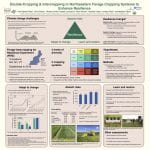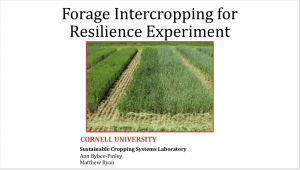How does climate change influence milk?
The next time you drink organic milk, think about the dairy cows and the forage they consume; growing this forage is disturbed by extreme weather events due to climate change. Organic dairy is an important industry in the Northeast because the majority of the nation’s organic dairy farms are here, producing 20% of the nation’s organic milk. In the Northeast, the predominant organic dairy forage system is based on cool season perennial grass and legume species, which become stressed by heat and drought. Extreme rainfalls and intense heat have increased in frequency and magnitude recently. These stress forage production and impact dairy operations.
Ann Bybee-Finley from the Sustainable Cropping Systems Lab studies how crop diversification practices can enhance the resilience of farms in the face of extreme weather events. This experiment examines what kind of diversity is helpful.

Ecological Concepts
Cropping systems are like stock portfolios, the more diversified they are, the less risky they are. Resilience is how able you are to deal with risk and depends on your capacity to absorb stress, adapt to a stress, and to return to a function after a stress. Absorptive capacity helps a cropping system absorb risk (e.g. intercropping, improving soil health, tile drainage). Adaptive capacity helps a farmer respond to an extreme weather event (e.g. double-cropping, planting an “emergency forage”), and Restorative capacity is given by institutions or networks that help a farmer continue farming after crop failure (e.g. crop insurance, disaster payments).
Resilience capacity (left) and the timing of double cropping (right) are illustrated below. Overall resilience capacity is maximized with redundancy within and among adaptive, absorptive, and restorative capacity components.
The goal of this project was to enhance the resilience of organic farming systems in the Northeast through research and development of two crop diversification practices 1) intercropping and 2) double-cropping.
Intercropping
Intercropping is growing multiple crops at the same time, for instance sudangrass, sorghum sudangrass, and pearl millet—instead of just a single crop. Increased resilience from intercropping forage mixtures can be attributed to complementarity among species with differing traits, like a long tap-root or a branching, fibrous roots. In the long-term, growing a diverse mixture increases the probability of having at least one species that responds positively to any environmental condition and reduces the variability of production across years. Increased diversity also lowers the risk of pest and disease problems and increases insect and soil microbial diversity.
Double cropping
Double cropping is harvesting two or more annual crops in a single growing season. Summer annual crops, like sudangrass are seeded in early summer, can be harvested 1-2 times, and provide an opportunity to establish a winter annual forage crop at the end of summer. Winter annuals, like triticale keep the soil covered over the winter and provides a forage crop in the spring. Double cropping gives farmers the flexibility to be responsive to an extreme weather event. If they can’t establish corn in the spring, a short season summer annual can get them back on track. Production of annual crops can supplement periods of low perennial forage production by ensuring the availability of high-quality forage crops during periods of low cool season forage productivity. Growing annual forage crops with perennials can increase forage reserves and build resilience.
Our Experiment
- Experiment started in Fall of 2016 and ended in Spring 2019.
- Took place on 3 research farms in NY, VT, and NH.
- Each location at 2 different systems each with 4 different diversity treatments
- Perennial system: based on alfalfa and grasses and clover were added
- Double-cropped system: triticale-based winter annuals and sudangrass-based summer annuals
- Each species in a mixture was seeded using a replacement rate (monoculture rate of a species/# species in the mixture). Each variety seeding rate matched the population density (# of seeds) of a designated ‘head’ variety.
We measured at each harvest:
- Crop performance: biomass production by species. Did certain diversity treatments have better yields or have greater yield stability? If so, why?
- Weed abundance: weed biomass by species. What diversity treatments had lower weed biomass? Did the weed community change because of diversity treatments?
- Forage quality: crude protein, acid detergent fiber, and neutral detergent fiber using NIR. Did forage quality change with the diversity treatments? If so, why?
- We also examined soil health, system profitability, soil enzymes and microbial diversity.
Results
In total, we sampled biomass from 37 harvests across the 3 sites. Because the number of harvests for each crop (winter annual, summer annual, and perennials) differed by site, we focused our analysis on the role of diversity in intercropping and examined each crop separately.
In the 9 harvests of winter annuals, we saw that the Heterospecific and High treatments produced more biomass and had higher NDF. This is because the cereal rye matured faster than the triticale and was in the stem elongation stage, while triticale was in a late boot stage. Winter pea and red clover made up less than 1% of winter annual biomass because they where outcompeted by the grasses during establishment. Here, adding diversity helped in reducing weed biomass when growing winter annuals for multiple years.
In the 10 harvests of summer annuals, the different diversity treatments produced similar amounts of biomass with similar forage quality. Ryegrass was heavily outcompeted by the other species. When considering the seed costs, the Heterospecific treatment was the most economical choice.
In the 18 harvests of the perennials, the Heterospecific and High treatments produced more biomass. These treatments also had lower weed biomass, lower crude protein, and higher NDF. This is the consequence of adding orchardgrass to the alfalfa. The timothy and the white clover produced a smaller amount of biomass compared to the other two species. Adding grasses to the alfalfa was also more economical. Within a year, the percentage of grass biomass was highest in the 1st and 4th cuts, whereas the alfalfa biomass was greater in the 2nd and 3rd cuts when the ‘summer slump’ was happening.
More diversity increased yield stability in the crops, especially in the perennials. The differences in soil health were due to the different tillage practices and fertility regimes in either system, but not for diversity treatments.
Explore the educational materials below to see more results from this project.
 |
|
|
|









